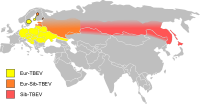
Photo from wikipedia
Abstract National parks are unique and significant vector-borne pathogen transmission settings, engaging over 300 million people in outdoor recreation per year. In this study, we integrated vector surveys and ecological… Click to show full abstract
Abstract National parks are unique and significant vector-borne pathogen transmission settings, engaging over 300 million people in outdoor recreation per year. In this study, we integrated vector surveys and ecological habitat feature data in spatial models to characterize tick-borne disease exposure risk in Acadia National Park (ANP), Maine. To determine the broad-scale patterns of blacklegged tick Ixodes scapularis Say (Acari: Ixodidae) densities in ANP, we conducted host-seeking tick collections at 114 sites across the park over two years. Using these tick survey data and geospatial landscape feature data (i.e., land cover, elevation, forest patch size, and aspect) we developed a random forest model of nymphal tick density. We found that host-seeking tick density varies significantly across the park and is particularly high in areas characterized by deciduous forest cover and relatively low elevation. To explore potential fine-scale ecological drivers of tick density spatial patterns, we quantified microclimate conditions, host activity, and vegetation characteristics at a subset of 19 sites. We identified significant differences in microclimate conditions but not host activity or vegetation metrics across broad-scale landscape feature classes. Mean temperature and mean humidity were correlated to nymphal densities and therefore may provide a mechanistic link between landscape features and blacklegged tick densities. Finally, we detected multiple tick-borne pathogens in both ticks and small mammals sampled in ANP, including Borrelia burgdorferi, Babesia microti, and Anaplasma phagocytophilum. Our findings demonstrate the value of using ecological metrics to estimate vector-borne disease exposure risk and provide insight into habitat characteristics that may drive tick-borne disease exposure risk.
Journal Title: Journal of Medical Entomology
Year Published: 2022
Link to full text (if available)
Share on Social Media: Sign Up to like & get
recommendations!